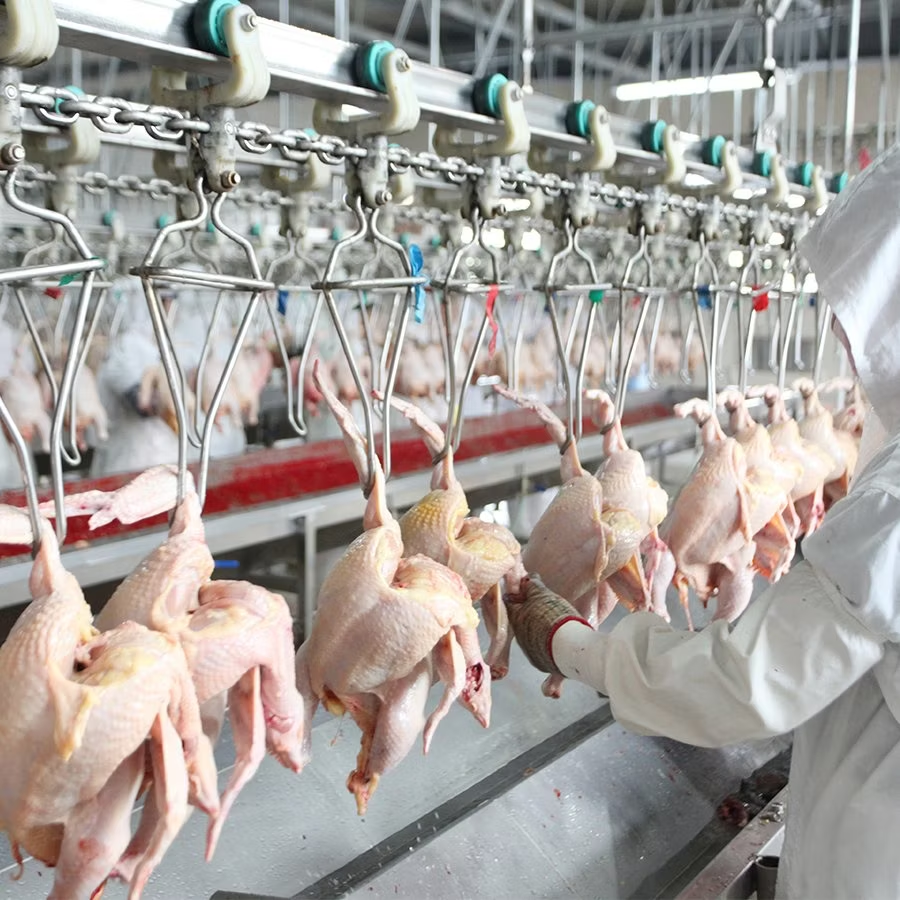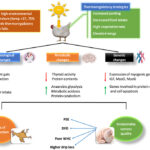
Poultry, like all animals, require a balanced diet that meets their physiological needs for growth, reproduction, maintenance, and production (meat or eggs). The essential nutrients include water, energy (carbohydrates and fats), proteins (amino acids), vitamins, minerals, and enzymes. The optimum levels vary based on species (broiler, layer, breeder), age, production stage, and environmental conditions.
1. Energy (Metabolizable Energy – ME)
Energy is the most critical component as it fuels all biological functions. It’s typically supplied through carbohydrates and fats.
- Broilers: 3000–3200 kcal/kg (starter); 3100–3300 kcal/kg (finisher)
- Layers: 2700–2800 kcal/kg
- Breeders: 2700–2900 kcal/kg
Note: Energy density affects feed intake. High-energy diets reduce feed consumption, necessitating higher nutrient concentrations.
2. Proteins and Amino Acids
Protein is crucial for tissue synthesis, enzyme and hormone production. However, amino acids, the building blocks of protein, are the actual nutrients utilized.
Key Amino Acids (with typical % of diet):
| Amino Acid | Broiler Starter | Broiler Finisher | Layer | Breeder |
|---|---|---|---|---|
| Lysine | 1.1–1.3% | 1.0–1.2% | 0.7% | 0.85% |
| Methionine | 0.5–0.6% | 0.4–0.5% | 0.3% | 0.4% |
| Threonine | 0.75% | 0.65% | 0.5% | 0.65% |
| Tryptophan | 0.2% | 0.18% | 0.16% | 0.18% |
Note: Imbalance in amino acids leads to poor growth, feathering issues, and reduced egg production.
3. Fats and Essential Fatty Acids
Fats increase energy density and supply essential fatty acids like linoleic acid (important for egg size and hatchability).
- Fat: 3–6% of total diet
- Linoleic acid: Minimum 1% in layers and breeders
4. Vitamins
Vitamins are organic compounds essential for metabolic processes. Both fat-soluble (A, D, E, K) and water-soluble (B-complex, C) are required.
Optimum Inclusion Rates (per kg of feed):
| Vitamin | Broiler | Layer | Breeder |
|---|---|---|---|
| Vitamin A | 10,000–15,000 IU | 8,000 IU | 10,000 IU |
| Vitamin D3 | 2000–5000 IU | 3000 IU | 4000 IU |
| Vitamin E | 20–100 mg | 25 mg | 100 mg |
| Vitamin K | 2–3 mg | 2 mg | 2.5 mg |
| B1 (Thiamine) | 1–2 mg | 1 mg | 2 mg |
| B2 (Riboflavin) | 4–6 mg | 3 mg | 6 mg |
| Niacin | 20–60 mg | 30 mg | 60 mg |
| Pantothenic acid | 10 mg | 5 mg | 12 mg |
| Folic acid | 1 mg | 0.5 mg | 1.5 mg |
| Biotin | 0.15–0.3 mg | 0.2 mg | 0.25 mg |
| Vitamin B12 | 10–20 µg | 10 µg | 20 µg |
| Vitamin C | 100–200 mg (optional) | 100 mg | 100–200 mg (under stress) |
5. Minerals
Minerals are vital for skeletal health, egg shell quality, enzyme functions, and metabolic reactions.
Macro-minerals (in % of diet):
| Mineral | Broiler | Layer | Breeder |
|---|---|---|---|
| Calcium (Ca) | 0.9–1.0% | 3.5–4.5% | 2.5–3.5% |
| Phosphorus (available P) | 0.45–0.6% | 0.35–0.4% | 0.4–0.5% |
| Sodium (Na) | 0.15–0.2% | 0.15% | 0.15% |
| Chloride (Cl) | 0.2% | 0.2% | 0.2% |
| Potassium (K) | 0.4% | 0.4% | 0.4% |
Trace Minerals (mg/kg of diet):
| Mineral | Broiler | Layer | Breeder |
|---|---|---|---|
| Iron | 80–100 | 50–80 | 80–100 |
| Copper | 8–15 | 5–10 | 8–15 |
| Zinc | 80–120 | 50–100 | 100 |
| Manganese | 60–120 | 70–100 | 120 |
| Iodine | 0.3–0.5 | 0.35 | 0.4 |
| Selenium | 0.15–0.3 | 0.2 | 0.3 |
6. Water
Often overlooked, clean, fresh water is the most critical nutrient.
- Water requirement increases with temperature, feed intake, and salt/protein content in the feed.
- Birds generally drink 1.5 to 2.5 times the weight of feed consumed.
7. Enzymes and Feed Additives
Modern poultry diets often include exogenous enzymes to improve nutrient digestibility and reduce feed cost.
- Phytase: Improves phosphorus availability
- Xylanase, β-glucanase: Enhance digestion of NSPs in wheat/barley-based diets
- Probiotics and Prebiotics: Improve gut health
- Coccidiostats and Antioxidants: For disease prevention and oxidative stress reduction
Conclusion
Formulating poultry rations with optimum nutrient levels is essential for:
- Maximizing productivity (growth rate, egg yield, FCR)
- Ensuring bird health and welfare
- Reducing environmental waste
- Optimizing economic returns
Formulations must consider breed genetics, age, environmental conditions, and local feed ingredient availability. Regular evaluation and updates based on performance and feed analysis are essential for maintaining optimum nutrition.




Good information